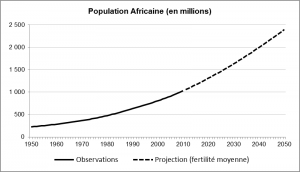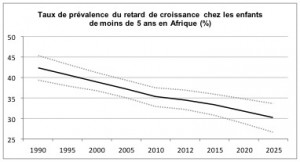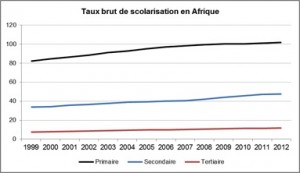Africa's future is generally described by two figures : 5.2 % and 2 billion. The first figure published in the 2012 Africa Economic Outlook* is the average growth rate of the GDP in Africa from 2003 to 2011. The second figure is the expected growth of the population in Africa by 2050 predicted by the United Nations population division in 2012. These figures are systematically used in reports, articles and by economists. More and more studies are questioning the accuracy of the 5.2 percent growth rate. However, the demographic prospects do not seem to be questioned at all. Demography is a challenge and it is important to create economic prospects for the local consumers, investors and the State.
The latest population projection of the United Nations has stated that the African population should reach 2.4 billion by 2050. This is the double of the population in 2010. This projection makes Africa the most populated region in the whole world, way ahead of China and India. This situation is very challenging geopolitically and economically. Yet, in this article, we shall only focus on the economic challenges presented by this population doubling. Even if the current level of productivity were maintained, each person in Africa will have to be equipped with the same work tools we have today to maintain the income per capita. Thus, the doubling of the population will also combine the doubling of the potential market and eventually of the cash flow for investors. Hence, demographic prospects are undeniably a strong argument to attract investors.
 Source: Graphic presentation of the author based on data from World Population Prospects
Source: Graphic presentation of the author based on data from World Population Prospects
Prospects: the 2012 revision of the division of the population (United Nations)
However, more benefit can be derived from this population prospect by increasing the productivity of the new generations of workers from now on. African workers should be equipped with more productive tools. The use of new information technologies, the construction of transport and energy infrastructure have to be taken into account as well. Still, this approach does not take into account the increase in the « human » productivity of the worker which is more important for the use of more elaborate and productive tools. Thus, it is all the more important to improve the general health and education of the population so that the investors, the population and the State can benefit from these demographic prospects.
Even though there has been some progress in human development in the past few decades, there are bigger challenges ahead of us. Here we are not going to focus on classic indicators such as lifespan, birth rate and schooling rate but on new levers that could be used to improve the productivity of the future generations of African workers.
As far as health is concerned, recent studies such as the one conducted by Nobel Prize winner James Heckman among Jamaican children have shown that the first two years of one's life are the most important. More specifically, this study showed that the psychologic and social stimuluses received by Jamaican children in their first two years of life have a significant effect on their earnings twenty years later. Actually, their salaries have increased by 42 % on average, suggesting that a good nutrition and a positive social environment in the first two years has an important impact on the future of children.
Source : Calculations of the author based on data from the World Health Organisation
There is currently a lack of reliable statistics on child nutrition in Africa. As we can see in the graph above, 35 % of children aged 5 or less suffer from stunting in 2010. The WHO expects this rate to decrease but it will still be over 25 % by 2025. One child out of 4 will still be stunted.
In a recent press release, the UNICEF has explained that stunting is not simply an issue of low height stature; but an indicator of their health and productivity as an adult. Neurologists also agree to say that stunting is correlated with a lack some cognitive abilities. Unfortunately, after the age of 5, this cognitive skills can no longer be acquired, thus limiting the child's future economic productivity; that is to say his welfare. Hence, it is all the more necessary to take action as soon as possible to avoid these deficiences for the upcoming generations. The children born from 2015 to 2030 will be 20 to 25 years old in 2050. They will be the next generation workers in 2050.
Education is another major challenge. Some progress has been made as seen in the graph below. Access to primary education has become universal as of the year 2012. Likewise, secondary and tertiary enrolment has slightly increased. However, the enrollement rates, especially in the teriary education, are still very low.
Source: Calculations of the author based on data from the UNESCO
Another issue is the mismatch between supply and demand on most of African labor markets. As a matter of fact, the more educated are much more likely to be unemployed. This does not imply that students should be discouraged from pursuing long studies and follow vocational trainings. A recent study by the International Labour Office** showed that in 8 countries in Africa, the new graduates who found a job earned higher salaries than the job seekers with lower level of education.
Therefore, the education level is not the problem. It is rather the type of education that determines employability. It is important to encourage studies adapted to the needs of the labour market and to improve the quality of the education. The State can implement specific education counceling programs for the youth in collaboration with the private sector and subsidise vocational training programs adapted to the specific needs of the private sector. This program can be funded by a specific tax on the revenues of companies or the companies can themselves fund these vocational training programs with the financial help of the State.
Above all, Africa is considered in this anlysis as a single nation and market. However, the situation is not the same across all of the African countries. Moreover, analysts often make a parallel between Africa's demographic prospects and China's. Still we believe that governing 2 billion people within a single nation is not the same as dealing with the same amount of individuals scattered in 54 different states. Nonetheless, the conclusions in this article do apply to the majority of African countries, though they have to be tailored with specific contexts.
Georges Vivien Houngbonon
Translated by: Bushra Kadir
* Studies by Morten Jerven on the quality of macroeconomic statistics in Africa and the African Development Bank publications and the inclusive growth in Africa study published by Afrique des Idées
** The inequalities are not studied here, given that we cannot predict its evolution.
Sources :
Elder, S., Koné, K. S. 2014. Transition vers le marché du travail des jeunes femmes et hommes en Afrique Sub-Saharienne. Work for Youth N°10. Bureau Intenational du Travail
Gertler, P., Heckman, J., Pinto, R., Zanolini, A., Vermeesch, C., Walker, S., Chang, S., Grantham-McGregor, S. 2013. Labor Market Returns to Early Childhood Stimulation: A 20-Year Follow-up To An Experimental Intervention In Jamaica. NBER Working Paper Series.
Morten Jerven. 2013. Poor Numbers: How We Are Misled by African Development Statistics and What to Do about It. Cornell University Press
Economic Outlook, 2012. Development Centre OECD.
Progress shows that stunting in children can be defeated, Communiqué de Presse. Avril 2013. UNICEF.


